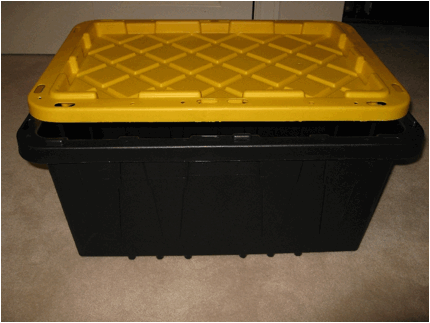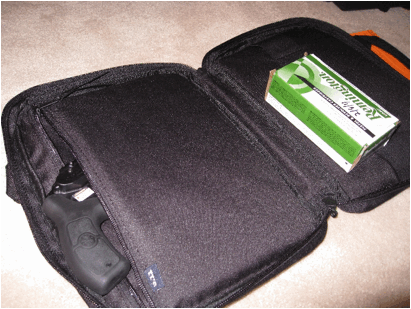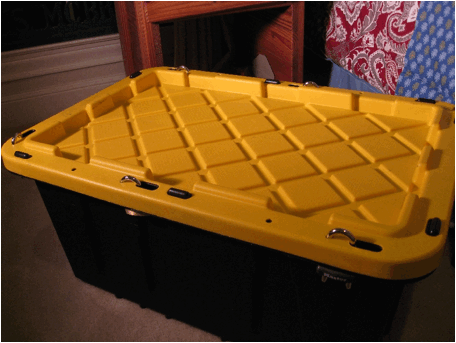[ This guest post was written by Alex from San Antonio. ]
I’m not a frequent flier and luckily I don’t have to fly often. As it is, I dislike airline travel … and I’m thrifty. However, every once in a while my wife forces my hand and demands a vacation outside the Lone Star state. So this year, my family and I planned a vacation to Florida over Spring Break.
We were flying Continental and there was no way we were going to be able to fit everything we needed for a weeklong vacation in three carryon bags. Continental charges $25 for every bag that gets checked. Not too bad, right? Except that you have to come home eventually and it’s another $25 to bring the checked bag back with you. The thrifty in me says, “Screw that! 50 bucks for one bag.” The realist in me says, “$50 for one bag. You know what? I’m going to travel with my handgun because I’m allowed and I may as well do it just for the experience of being able to conceal carry in a state that shares Texas reciprocity.”
My wife says, “Don’t fudge up our vacation with your less than intelligent ideas, sweetie.” (Not exactly what she said, but close enough).
I’ll admit I was a little bit hesitant about flying with a firearm in checked baggage, but it turned out to be a walk in the park. My research begins with visits to the Continental website regarding checked baggage and the TSA website regarding flying with firearms. Fortunately, the Continental requirements were no more stringent that the TSA’s requirements.
The first obstacle I had to overcome was buying a TSA required hard sided case for the firearm. I need a hard sided case that would fit both my son’s and my clothes and my .38 S&W 642. I don’t want to check two bags and pay twice the fees.
Searching for a hard sided case that satisfies both TSA’s and my requirements isn’t easy. First, I don’t want to pay hundreds of dollars for a case that’s too small and won’t get used often. Second, I don’t want the case to advertise that it contains something valuable or “gun like”. Third, I want the case to be secure enough to dissuade a dishonest baggage handler from reaching inside and sticking my S&W 642 in his cargo pants pocket. Finally, the case must be light enough so that I’m not exceeding the 50 pound weight limit for checked bags otherwise I have to pay a surcharge.

I decide on a $10 plastic storage bin from Lowes. An easily identifiable and low key 17 gallon black bin with a yellow lid. Though the bin already has several pre-drilled holes for locks, I enlarge four existing holes and create two additional holes. Now the bin will easily accept six ordinary padlocks. Four padlocks are keyed the same and two padlocks are keyed differently than the other four but keyed identical to each other. Hence, I only have to carry two keys for all six locks. The six padlocks do a fantastic job of securing the lid nice and tight. Once locked, I cannot stick a finger under the lid. As per published regulations, the locks must NOT be TSA approved locks. Also, no one is allowed to open my luggage containing a declared firearm unless I am present and the keys must never leave my person.


At a local Target I find a package of five 10 gallon Ziploc bags for less than $6. I place the clothes inside the bags and place the bags in the bin. I place 10 rounds of Hornady personal protection .38’s inside an empty 50 round box of Remington .38’s and then I place both the Remington box and my unloaded S&W in a soft sided pistol case. Into the bin it goes. It’s important that I place the S&W in a soft sided case so that neither the airline agent nor a TSA agent can require me to lock the firearm case separate from my luggage and ask me to check the firearm separately. I don’t want to check two bags and neither do I want to go lock up my S&W in my car at airport parking for a week.

At the airport, I ask the Continental employee for a firearm declarations tag. She asks me to unlock the case so that I can show her the weapon is unloaded. I do so. I place the weapon and the signed firearms tag back in the bin and lock it up. I’m escorted by a Continental employee to the TSA screening area where the TSA is screening all checked baggage. A TSA agent takes the bag from the Continental employee and places it on an X-Ray machine (or whatever the modern equivalent of an X-Ray machine might be). I wait for the bin to come out the other end. The TSA agent gives me a thumbs up, I say, “Thank you.”, and walk back to join my wife and son waiting for me to go through the screening area for boarding. Easy enough. I don’t see my bag again until I pick it up from the luggage carousel in Florida.
Flying home a week later was even easier. I again ask the Continental agent for a firearms declarations tag. I unlock the bin and demonstrate that the gun is unloaded. I place the gun and the tag back in the bin and lock it up. This time, though, the agent places the bin on the belt behind her at the check-in counter and I don’t see it again until I get home to Texas.
I found the journey to be effortless. I neglected to make a hole in the lid wide enough for a checked bag label. But the airline agents were patient and helpful as I shoe horned the label through a hole that was too small. Double check the regulations before you fly with a firearm and I hope your experience turns out as peachy as mine.
 Your Privacy Choices
Your Privacy Choices
